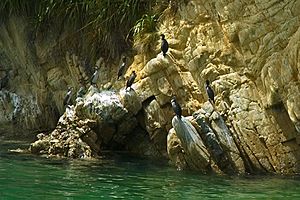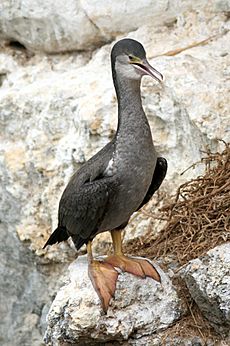Spotted shag facts for kids
Quick facts for kids Spotted shag |
|
|---|---|
 |
|
| Conservation status | |
| Scientific classification | |
| Genus: |
Phalacrocorax
|
| Species: |
punctatus
|
The spotted shag or pārekareka (Phalacrocorax punctatus) is a special type of cormorant bird. It lives only in New Zealand. This bird is known for its unique look and how it dives for fish in the sea.
Contents
About Its Name and Family
The spotted shag has had a few different names over time. When it was first found, a scientist named Johann Reinhold Forster called it the 'crested shag'. This was back in 1786. Another scientist, Anders Sparrman, described it as Pelicanus punctatus.
Later, some scientists thought it was so different that they put it in its own group called Stictocarbo. But after more studies, especially looking at its DNA, they found it actually belongs with the other typical shags in the Phalacrocorax group. Its closest relative is the Pitt shag.
What Does It Look Like?
The spotted shag is a medium-sized sea bird. It usually stands between 64 and 74 centimeters (about 25 to 29 inches) tall. It weighs between 700 and 1200 grams (about 1.5 to 2.6 pounds).
These birds have a slim body and a special black crest on their head. This crest looks like two small horns. Their beak is long, thin, and hooked, with an orange-brown color. Their feet are yellow-orange.
Their feathers are grey and blue. Adult birds have small black spots on their backs and wings. This is how they got their name! Their eyes are brown, with a blue ring around them. Just before they breed, a small patch of skin on their face turns green-blue.
When they are not breeding, adult shags lose their crests. Their belly feathers also look paler. Male and female spotted shags look very much alike. It's hard to tell them apart just by looking. However, you can tell them apart by their calls and how they act during mating.
They are usually quiet birds. But when they are resting or nesting, they make loud grunting sounds. When they fly, they often form a V-shape in the sky.
Where Do They Live?
Spotted shags live only in New Zealand. They build their nests along the coastlines and on some islands. You can find many of them on the South Island, especially on the west coast and near Stewart Island. They also live in some places on the North Island.
During breeding season, they stay close to their nesting sites. At other times, they spread out to other coastal areas. Large groups can be seen around Banks Peninsula near Christchurch. Another famous spot is 'Shag Rock' in Wellington Harbour.
These birds like to nest on cliffs along rocky coasts. They use ledges or cracks in the rocks. They often form very large groups, with over a thousand birds nesting together. They rarely go into freshwater or closed river mouths. Their nests are made of sticks and often lined with seaweed.
Reproduction and Life Cycle
Spotted shags usually lay three blue eggs, but sometimes they lay one to four. Both parents take turns guarding the eggs for about 30 days. When the chicks hatch, they are blind, naked, and very weak. They beg their parents for food.
- Days 4-6: Their eyes start to open.
- Days 7-11: They get stronger and start calling loudly for food. Soft down feathers begin to cover their bodies.
- Days 12-17: Their down feathers get thicker, and they become more active, flapping their wings.
- Days 18-23: They move around more quickly, though still a bit clumsy. Their tail feathers start to grow.
- Days 24-30: Spotted feathers start to grow on their wings. Some chicks may begin to leave the nest.
- Days 30-35: The birds are almost adult size, but still have some down.
- Days 35-50: Adult feathers fully grow in, and their tail is complete. Many young birds leave the nests to form small groups.
Chicks do not leave the nest for good until they are at least 52 days old. Spotted shags can breed all year round. They form pairs that stay together for breeding. Sometimes, their nesting groups can have as many as 700 pairs! Both parents share the jobs of sitting on the eggs and raising the chicks. They feed their young right in the nest.
It's common to see red-billed gulls near spotted shag colonies. When parent shags leave the nest to find food, gulls sometimes fly to the nest. They stand at the edge and make loud noises. This makes the young shags spit up some of their food, which the gull quickly eats!
After breeding, most spotted shags stay within 200 kilometers (about 124 miles) of their nesting areas. In winter, they form large groups of up to 2000 birds. They often fly in long lines between where they eat and where they rest.
What Do They Eat?

Spotted shags can fly up to 16 kilometers (about 10 miles) offshore to find food. They mainly eat small fish and other small sea animals like crabs or shrimp. They catch fish by diving from the water's surface. They use their webbed feet to swim underwater.
They usually dive for about 30 seconds. After a dive, they rest on the surface for 10 to 15 seconds before diving again. The longest dive ever recorded was 70 seconds! Spotted shags sometimes have small stones in their stomach. These stones might help them grind food or get rid of unwanted tiny creatures inside them. You might see them fishing alone, but often many shags fish together.
Threats to Spotted Shags
Sometimes, spotted shags get caught by accident in fishing nets and drown. They can also get tiny creatures called lice and ticks on their bodies. However, scientists believe that spotted shags are not greatly affected by many predators or serious diseases.
Conservation Status
The spotted shag is currently considered a species that is not threatened. This means their numbers are stable and they are not at risk of disappearing.
In Culture
In 1988, New Zealand released a series of postage stamps featuring its native birds. The spotted shag was shown on the 60-cent stamp.
See also
 In Spanish: Cormorán moteado para niños
In Spanish: Cormorán moteado para niños




